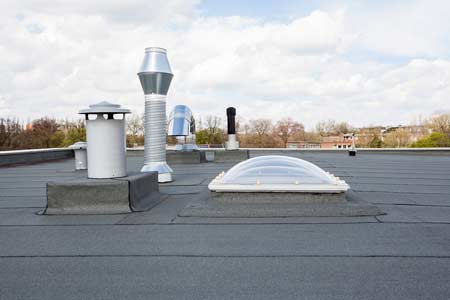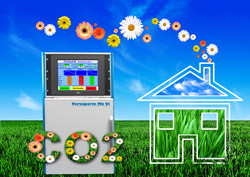

(along with other building barriers and fabrics)
 Although there is often confusion between airtightness and the water vapour permeability of roofing felts and other building barrier materials, they are very different things although they both relate to permeability. They are required to conform to different Building Regs and guidelines.
Although there is often confusion between airtightness and the water vapour permeability of roofing felts and other building barrier materials, they are very different things although they both relate to permeability. They are required to conform to different Building Regs and guidelines.
Air tightness (also called envelope airtightness) is the resistance to wind or air's inward or outward leakage through not only roofing felts but also a building's walls, doors, windows, and ventilation systems and is caused by wind and differential pressure conditions between the inside and outside of the building. It causes thermal comfort / discomfort and has a cost in energy and bills.
Water vapour permeability relates to the building material's, structure, vapour barriers and ventilations ability to keep water out. This is important for roofing felts etc. as water vapour can seep (or permeate) through every material, even ones that are impermeable to liquid water. This includes vapour barriers. The resultant moisture in side the building affects the health of both the building itself and the people inside it. It also relates to energy flow and bills. It is sometimes called Breathability - in the same way as some waterproof clothes are "Breathable".
The best values of both of these can result in
Airtightness relates to Building Regulations approved document Part L1A 2010 now specify that any new dwellings are built airtight. ... Standard good practice for air tightness testing in the UK is a maximum of 7 m3/hr/m2 and best practice is 3 m3/hr/m2 of air loss.
 Vapour permeability relates to Building Regulations ????? (details needed)
Vapour permeability relates to Building Regulations ????? (details needed)
At Versaperm we have designed a single novel piece of equipment that can measure both of them for roofing felts along with other building barrier fabrics. Both measurements are vital in controlling the environment within a building, including its thermal conductivity, ventilation and vapour barrier characteristics. The new equipment is both accurate and easy to use and offers considerably lower costs than conventional testing.
The equipment can, if required, also make these measurements under controlled environment conditions over a temperature range that easily exceeds regulatory considerations as well as having the ability to control humidity and simulate both diurnal and seasonal changes.
Results from the system are typically accurate in the parts per million (ppm) range and it can optionally measure permeability not just for air and water vapour but also for CO2, hydrocarbons, oxygen and virtually any other gas or vapour.
Versaperm is a world-technology leader and offers not just equipment but also a fast turn-around building products lab testing service.
For a press release on this equipment click here